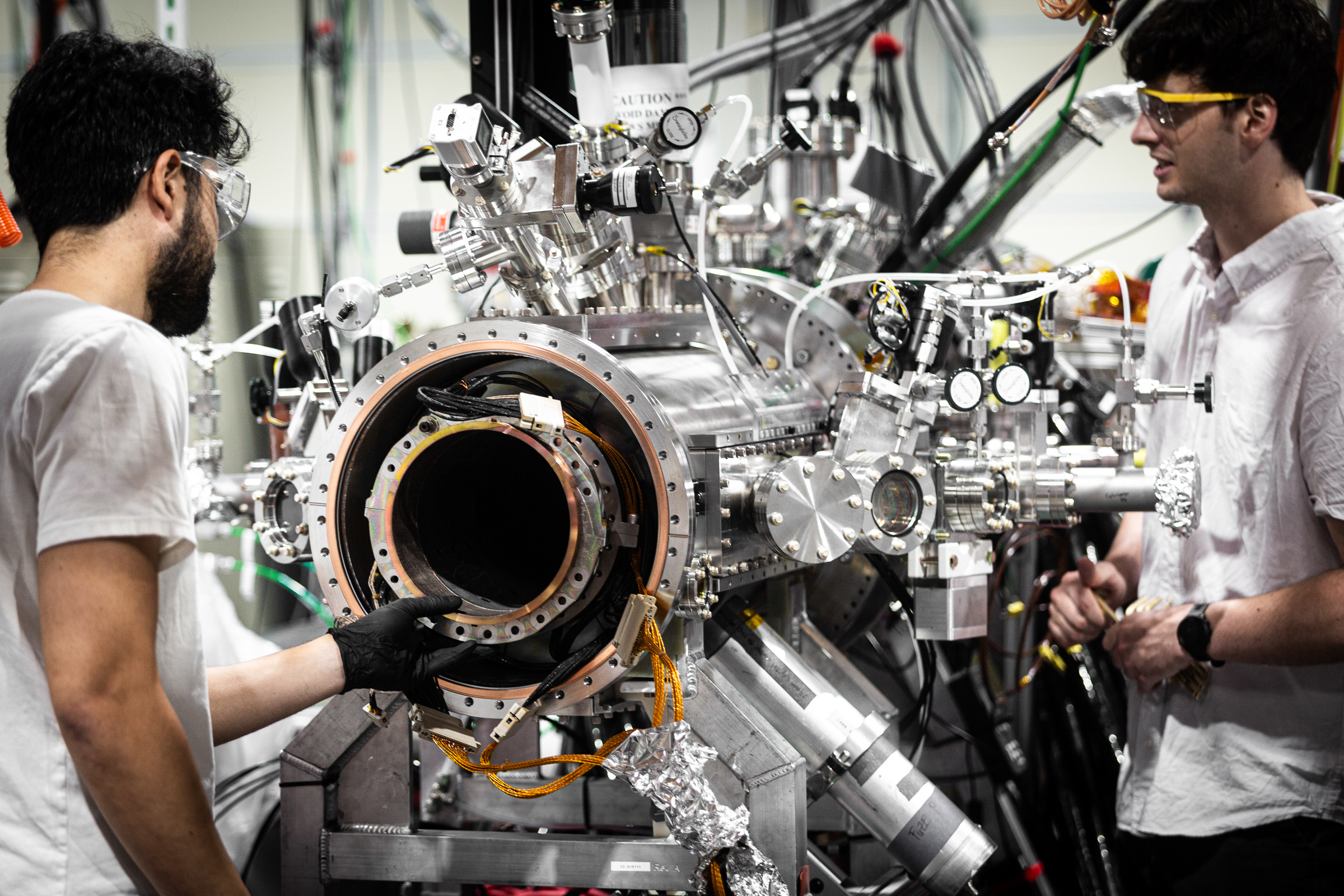Press release
/
November 18, 2025
Next generation of fusion device reaches record plasma pressures in a sheared-flow-stabilized Z pinch

Operating a new device named the Fusion Z-pinch Experiment 3, or FuZE-3, Zap Energy has now achieved plasmas with electron pressures as high as 830 megapascals (MPa), or 1.6 gigapascals (GPa) total, comparable to the pressures found deep below Earth’s crust. The results are the highest-pressure performance to date in a sheared-flow-stabilized Z pinch and an important marker on the path to scientific energy gain, or Q>1.
FuZE-3 is Zap’s first device to incorporate a third electrode to separate the forces that drive plasma acceleration and compression. Details of the preliminary results were presented today at the American Physical Society’s Division of Plasma Physics meeting in Long Beach, Calif.
“There are some big changes in FuZE-3 compared to Zap’s previous systems and it’s great to see it perform this well so quickly out of the gate,” says Colin Adams, Head of Experimental Physics.
Unlocking energy from fusion requires an extreme recipe of hot, dense plasma. Reaching high pressures, a measurement that combines temperature with density, is essential in fusion because the higher the plasma pressure, the more fusion reactions occur and produce energy. While some fusion machines strive for the highest pressures that can possibly be attained, others rely on longer confinement times to make up for low pressure. Zap’s sheared-flow-stabilized Z pinches aim for a middle ground that balances both compression and confinement.
Zap’s highest single-shot electron pressure measurement to date is 830 MPa. However, plasmas are more than just electrons; they are composed of both electrons and much heavier ions. If the temperature of both the electrons and ions are close to equal, as they are expected to be, the total plasma pressure (electrons and ions) is roughly double the electron measurements, or 1.6 GPa. A gigapascal is about ten thousand times the atmospheric pressure at sea level, or ten times the pressure at the bottom of the Mariana Trench.
The pressures were sustained for approximately a microsecond (one millionth of a second) and were determined using a technique called optical Thomson scattering, the gold-standard for such measurements.

The recent FuZE-3 campaigns include multiple repeated shots with electron densities in the range of 3-5x1024 m-3 and electron temperatures above 1 keV (equal to 21,000,000 degrees Fahrenheit).
“This was a major effort by the team that was successful because of a tightly coupled cycle of theoretical predictions, computational modeling, rapid build and test engineering, experimental validation, and measurement expertise,” remarks Ben Levitt, Vice President of R&D. “With a smaller system we have the benefit of being able to move quickly, and achieving these results in systems that are a fraction of the size and cost of fusion devices of comparable performance is a big part of what makes this such a significant accomplishment.”
FuZE-3 is the third generation of FuZE devices, and the fifth sheared-flow-stabilized Z-pinch device. Zap’s initial device FuZE was the first to exceed 1 keV temperatures and has now been decommissioned. FuZE-Q, Zap’s highest performing device by power and fusion neutron yield, remains in regular operation alongside FuZE-3.
FuZE-3 was designed to climb to new levels of triple product, an important metric in fusion that is the mix of three measurements: density, temperature and confinement time. Critically, it includes three electrodes and two capacitor banks.

Tests at Zap to date have relied on systems with a single pulse of electrical current conducting between two electrodes. This means that the power driven into the device must accelerate the plasma to provide stabilizing flow as well as compress the plasma into a Z pinch.
“The capability to independently control plasma acceleration and compression gives us a new dial to tune the physics and increase the plasma density,” explains Adams. “The two-electrode systems have been effective at heating, but lacked the compression targeted in our theoretical models.”
Though the new measurements demonstrate very high pressures, Zap’s physics is a form of quasi-steady-state magnetic confinement, not the inertial fusion physics targeted by systems that compress a target in nanoseconds using huge arrays of powerful lasers (or also in some cases Z pinches). For Zap’s approach, controlling plasma acceleration to generate and sustain stabilizing flow is as important as controlling compression.

Zap’s latest results remain preliminary as the team continues active scientific campaigns on FuZE-3. Further details are being presented this week at the APS DPP meeting and the team plans to publish FuZE-3 results in the scientific literature in the coming months.
“We’re really just getting started with FuZE-3,” says Levitt. “It was built and commissioned just recently, we’re generating lots of high-quality shots with high repeatability, and we have plenty of headroom to continue making rapid progress in fusion performance. We’ll be integrating lessons from FuZE-3 into our next generation systems as we continue advancing toward commercial fusion.”
While FuZE-3 tests are ongoing, Zap plans to commission yet another next generation FuZE device, scheduled to come online this winter. Power plant engineering continues in parallel, anchored by the Century demonstration platform.
About Zap Energy
Zap Energy is building a low-cost, compact and scalable fusion energy platform that confines and compresses plasma without the need for expensive and complex magnetic coils. Zap’s sheared-flow-stabilized Z-pinch technology provides compelling fusion economics and requires orders of magnitude less capital than conventional approaches. Zap Energy has 150 team members in Seattle and San Diego and is backed by leading financial and strategic investors.
Media Contact:
media@zap.energy